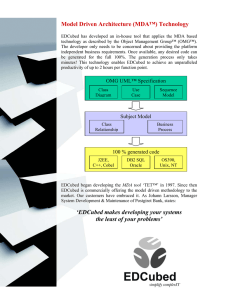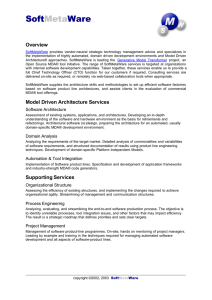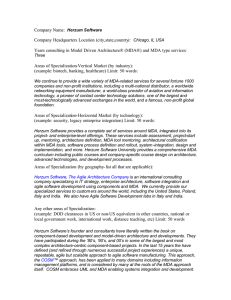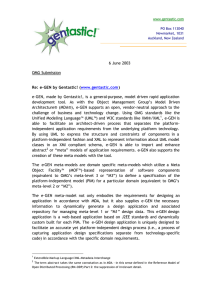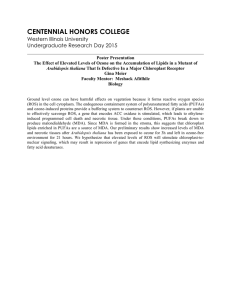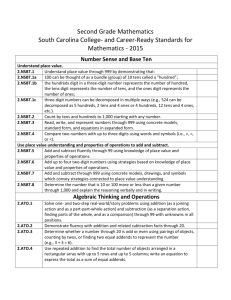What Senior Management Needs to Know About the Value of...
advertisement
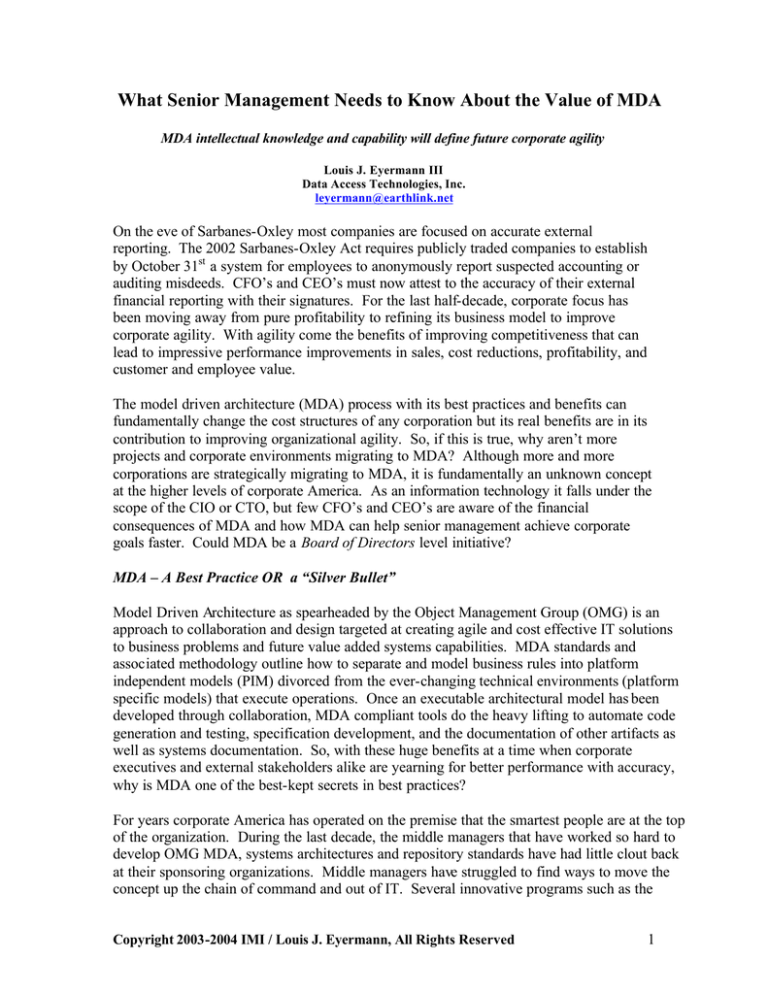
What Senior Management Needs to Know About the Value of MDA MDA intellectual knowledge and capability will define future corporate agility Louis J. Eyermann III Data Access Technologies, Inc. leyermann@earthlink.net On the eve of Sarbanes-Oxley most companies are focused on accurate external reporting. The 2002 Sarbanes-Oxley Act requires publicly traded companies to establish by October 31st a system for employees to anonymously report suspected accounting or auditing misdeeds. CFO’s and CEO’s must now attest to the accuracy of their external financial reporting with their signatures. For the last half-decade, corporate focus has been moving away from pure profitability to refining its business model to improve corporate agility. With agility come the benefits of improving competitiveness that can lead to impressive performance improvements in sales, cost reductions, profitability, and customer and employee value. The model driven architecture (MDA) process with its best practices and benefits can fundamentally change the cost structures of any corporation but its real benefits are in its contribution to improving organizational agility. So, if this is true, why aren’t more projects and corporate environments migrating to MDA? Although more and more corporations are strategically migrating to MDA, it is fundamentally an unknown concept at the higher levels of corporate America. As an information technology it falls under the scope of the CIO or CTO, but few CFO’s and CEO’s are aware of the financial consequences of MDA and how MDA can help senior management achieve corporate goals faster. Could MDA be a Board of Directors level initiative? MDA – A Best Practice OR a “Silver Bullet” Model Driven Architecture as spearheaded by the Object Management Group (OMG) is an approach to collaboration and design targeted at creating agile and cost effective IT solutions to business problems and future value added systems capabilities. MDA standards and associated methodology outline how to separate and model business rules into platform independent models (PIM) divorced from the ever-changing technical environments (platform specific models) that execute operations. Once an executable architectural model has been developed through collaboration, MDA compliant tools do the heavy lifting to automate code generation and testing, specification development, and the documentation of other artifacts as well as systems documentation. So, with these huge benefits at a time when corporate executives and external stakeholders alike are yearning for better performance with accuracy, why is MDA one of the best-kept secrets in best practices? For years corporate America has operated on the premise that the smartest people are at the top of the organization. During the last decade, the middle managers that have worked so hard to develop OMG MDA, systems architectures and repository standards have had little clout back at their sponsoring organizations. Middle managers have struggled to find ways to move the concept up the chain of command and out of IT. Several innovative programs such as the Copyright 2003-2004 IMI / Louis J. Eyermann, All Rights Reserved 1 MDA FastStart Program developed by the OMG are giving greater visibility to the OMG and its programs as well as MDA systems and repository standards, tools, best practices and knowledgeable, certified vendors. Now more and more senior managers are becoming knowledgeable of MDA and the value of the OMG thanks to better strategic planning and the increasing need for corporate agility. Empowering MDA and MDA Projects Implementing an MDA project requires buy- in at all levels, investment, planning, performance measurement and collaboration. Executive buy- in is best achieved by leveraging a business case, executive training and strategic planning best practices. There are several key activities or project workstreams that must come together to achieve success. These are: (1) the business case, (2) programmatics/ business planning (3) the technical solution; and (4) change management. In the case of a military project, add a fifth variable, modification of the acquisition process to include win- win incentives. This paper will address the business case and how to secure executive buy-in, and how to properly frame the MDA technical capability. Why concentrate on the business case? It is through the business case that we can quantify the significance of MDA and any MDA project. It is the single most powerful analytic tool utilized to prioritize projects and make decisions about allocating scarce financial resources. Return on Investment (ROI) speaks, talk is cheap. MDA Business Case & Audience A business case is nothing more than a financial representation of the significance of an investment project. Although business cases come in many different forms and flavors depending on the organization’s investment policies and practices, the MDA business case should focus on the significance of migrating to MDA versus business as usual. Keep it simple and focused on the orders of magnitude improvements offered by MDA. Start with clearly outlining the assumptions or benefits presented by MDA. The assumptions can be layered. As an example, begin with leveraging the MDA methodology to eliminate duplication of effort. Effective MDA project planning encourages a cross section of disciplines to come together to discuss the problem and agree on a design to the solution. As the problem or project is discussed, information is being captured in a model, not in a PowerPoint slide. The collaborative effort prevents duplicate planning processes across the organization. This is especially a big problem within the armed services. Instead of developing five different stove-piped solutions to solve a common problem, through the MDA collaborative process one common solution is built comprised of reusable components across the enterprise. The MDA collaborative process fosters the recognition of one common solution helping to drop the costs from 5X to 1.3 X even without applying the technology benefits of utilizing an MDA tool to automate the solution. Now model the solution with an MDA compliance tool that automates the code and other processes and the cost dramatically drops from 1.3X to .5 - Copyright 2003-2004 IMI / Louis J. Eyermann, All Rights Reserved 2 .65X. The MDA solution offers cost savings that are orders of magnitude better than business as usual. Remember, an effective business case must show at a high level the orders of magnitude difference from the current state project management approach, eliminating duplication of effort and the dramatic benefits of applying MDA. The savings in costs, time, and performance can be staggering. In 1999, automating code could produce benefits of 60:1 labor savings. Today, overlaying the testing of code, automating specification development and development of other artifacts such as reports, confirmations, etc., and the always less attractive systems documentation could produce a labor efficiency of 200:1. Considering that the information is now captured in a meta- model that can be refined and run through another iterative build cycle in a matter of days and minutes, MDA represents IT agility. This must be communicated in the business case as a key value proposition and financial benefit. As an IT professional, it is imperative that you enlist the CFO team’s assis tance to develop and refine the business case. Crossfertilizing the business case analysis by adding SME’s advice from other corporate disciplines will add tremendous credibility to the analysis and presentation as well as increase buy- in. As a business executive and process consultant, I believe that MDA represents the next best practice in IT for the next decade. We are only beginning to scratch the surface of its potential. MDA will define best- in-class organizations to include consulting firms. Your audience is the senior management team that reports directly to the CEO. More and more proponents of MDA are realizing that an effective business case is the key to MDA acceptance. Thus, the business case needs to be clear and simple incorporating the proper assumptions to communicate the significance of the financial impact. There are strategic and operational implications associated with a transformation to MDA. The short term or immediate project benefits involve creating executable architectures in the form of a platform independent model which allow automated code generation, testing of the code, automated specifications and artifacts and documentation. The longer-term strategic opportunities involve developing open software solutions based on reusing components that meet the test of OMG standards. Once a solution is built, software components can be harvested, stored and reused to build other solutions at significantly reduced costs. The reusable components composing each IT solution or new application are assets on your corporation’s balance sheet. This should also be figured into the business case. Securing Executive Buy-In As you begin to move forward, remember why you are developing the business case. It is to gain approval through executive buy- in. The best way to gain executive buy- in is through increasing executive understanding. This can be achieved in several ways. First, conduct several one-on-one executive presentations to introduce MDA by discussing the standards, best practices and its benefits. Gather and present the necessary information including expert opinions of analyst research, subject matter expert Copyright 2003-2004 IMI / Louis J. Eyermann, All Rights Reserved 3 evaluations and modeling demos, association facts, figures and references, publications, and best practices. Discuss the business case, its benefits, and its assumptions. Discuss the end state for your enterprise, the agile enterprise. Depending on the interest and state of affairs, the OMG is prepared to assist your efforts. MDA Technology Best Practices From a technology point of view, it is important that the entire MDA technical capability be framed properly. This involves outlining and discussing the standards, i.e., MDA (modeling and separation of business concerns), EDOC (systems of systems standards) and the MOF standards for the repository. Best practice processes should also be reviewed as well as the capabilities of MDA compliant tools. The two key processes include business (programmatics) and technology processes. The programmatics should leverage business best practices in strategic planning and change management. The technology processes should examine developing a factory approach to systematizing the rollout of MDA. Why a factory approach? A factory approach replicates the benefits of your business case, i.e., quicker time to market, lower costs, higher quality, better productivity and, above all, greater agility leading to a competitive advantage. The tools do the heavy lifting. They do the high level layout of a Platform Independent Model (PIM – the architecture) and provisioning between the PIM and the ever-changing technical environment (Platform Specific Model – PSM). Tools will generate the necessary code, test the code, automate artifacts, and the systems development documentation. There is no one tool but in fact a suite of tools that should be incorporated into the architect’s and developer’s tool set to be leveraged. Conclusion MDA must be presented objectively and in a format that senior corporate executives understand. This necessitates the development of an effective business case. The objective is simply to show the financial significance of what MDA, OMG standards and best practices could mean for your organization. The business case must show the orders of magnitude financ ial significance of MDA as it relates to both a change in the cost structures of your enterprise as well as how MDA creates a highly agile and profitable enterprise. As your senior executives wrestle with refining the timeliness and quality of internal financial reporting and reconciling the accuracy of external management reporting to comply with implementing the Sarbanes-Oxley legislation, MDA could be a very important best practice to achieve this goal. Copyright 2003-2004 IMI / Louis J. Eyermann, All Rights Reserved 4
